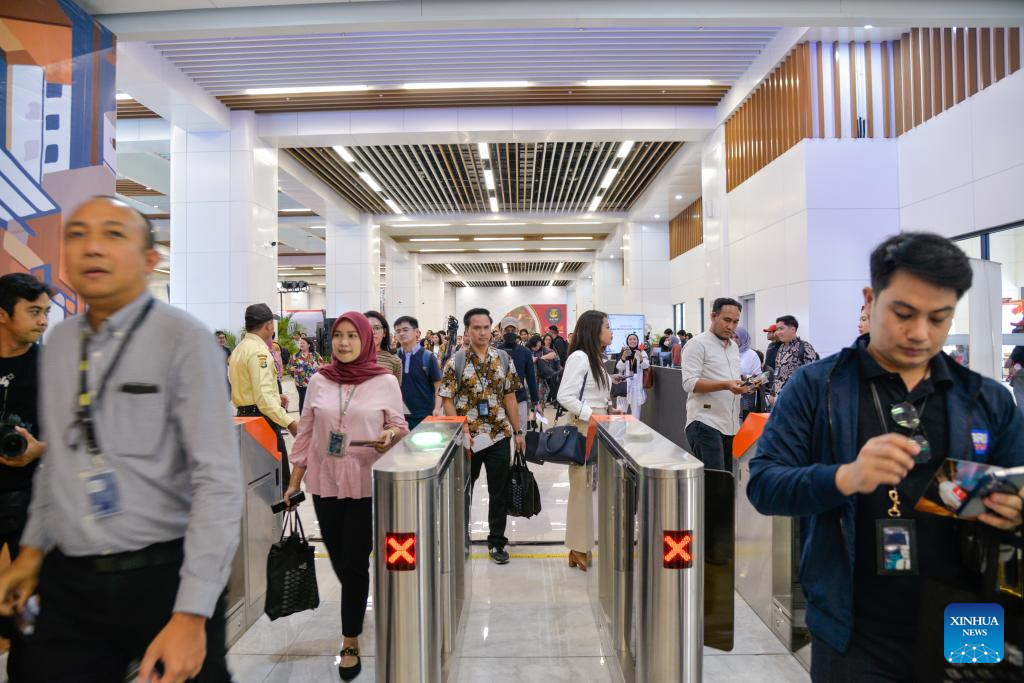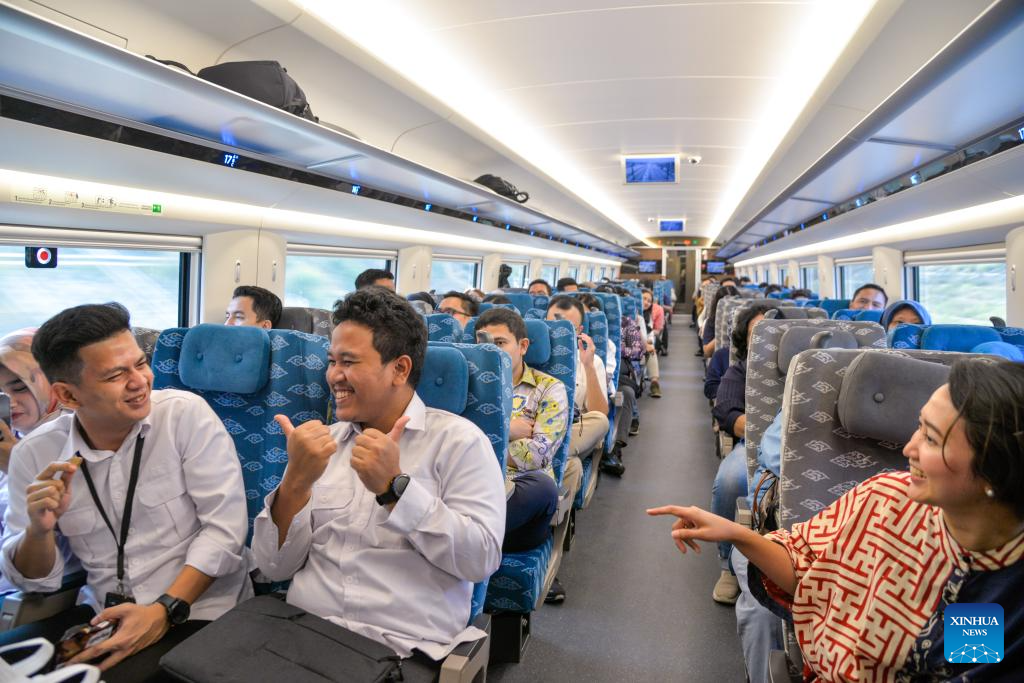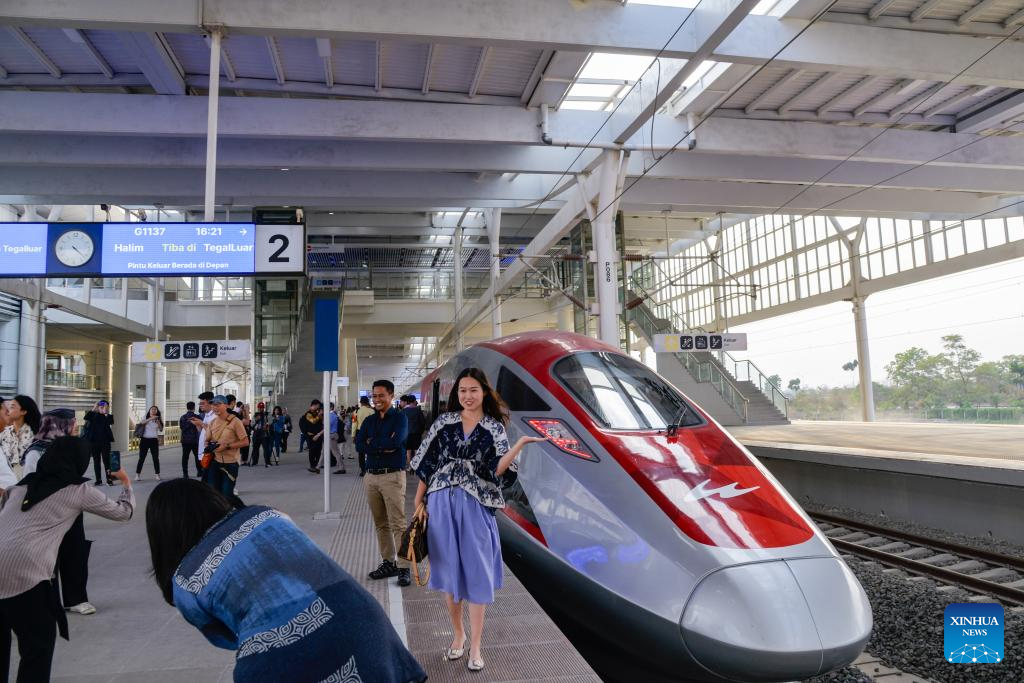
Passengers take selfies in a carriage of a high-speed electrical multiple unit (EMU) train running on the Jakarta-Bandung High-Speed Railway in Indonesia, Oct. 17, 2023. The Jakarta-Bandung High-Speed Railway (HSR) jointly built by China and Indonesia was officially put into commercial operation on Tuesday.
The 142.3 km long high-speed line, connecting Jakarta and the fourth largest city Bandung, is a flagship project that synergizes the China-proposed Belt and Road Initiative and Indonesia's Global Maritime Fulcrum strategy.
It is also the first overseas construction project that fully uses Chinese railway systems, technology and industrial components.
In addition to greatly cutting the journey between the two cities from over three hours to around 40 minutes, Indonesia's Transportation Minister Budi Karya Sumadi told Xinhua in an interview that the Jakarta-Bandung HSR would greatly promote regional people-to-people exchanges and drive the development sectors including tourism, employment and education. (Xinhua/Xu Qin)

People check in by swiping their tickets at the platform of Halim Station on the Jakarta-Bandung High-Speed Railway in Jakarta, Indonesia, Oct. 17, 2023. The Jakarta-Bandung High-Speed Railway (HSR) jointly built by China and Indonesia was officially put into commercial operation on Tuesday.
The 142.3 km-long high-speed line, connecting Jakarta and the fourth largest city Bandung, is a flagship project that synergizes the China-proposed Belt and Road Initiative and Indonesia's Global Maritime Fulcrum strategy. It is also the first overseas construction project that fully uses Chinese railway systems, technology and industrial components.
In addition to greatly cutting the journey between the two cities from over three hours to around 40 minutes, Indonesia's Transportation Minister Budi Karya Sumadi told Xinhua in an interview that the Jakarta-Bandung HSR would greatly promote regional people-to-people exchanges and drive the development sectors including tourism, employment and education. (Xinhua/Xu Qin)

Passengers chat in a carriage of a high-speed electrical multiple unit (EMU) train running on the Jakarta-Bandung High-Speed Railway in Indonesia, Oct. 17, 2023. The Jakarta-Bandung High-Speed Railway (HSR) jointly built by China and Indonesia was officially put into commercial operation on Tuesday.
The 142.3 km long high-speed line, connecting Jakarta and the fourth largest city Bandung, is a flagship project that synergizes the China-proposed Belt and Road Initiative and Indonesia's Global Maritime Fulcrum strategy.
It is also the first overseas construction project that fully uses Chinese railway systems, technology and industrial components.
In addition to greatly cutting the journey between the two cities from over three hours to around 40 minutes, Indonesia's Transportation Minister Budi Karya Sumadi told Xinhua in an interview that the Jakarta-Bandung HSR would greatly promote regional people-to-people exchanges and drive the development sectors including tourism, employment and education. (Xinhua/Xu Qin)

A crew member gestures to welcome passengers at the platform of Halim Station on the Jakarta-Bandung High-Speed Railway in Jakarta, Indonesia, Oct. 17, 2023. The Jakarta-Bandung High-Speed Railway (HSR) jointly built by China and Indonesia was officially put into commercial operation on Tuesday.
The 142.3 km long high-speed line, connecting Jakarta and the fourth largest city Bandung, is a flagship project that synergizes the China-proposed Belt and Road Initiative and Indonesia's Global Maritime Fulcrum strategy.
It is also the first overseas construction project that fully uses Chinese railway systems, technology and industrial components.
In addition to greatly cutting the journey between the two cities from over three hours to around 40 minutes, Indonesia's Transportation Minister Budi Karya Sumadi told Xinhua in an interview that the Jakarta-Bandung HSR would greatly promote regional people-to-people exchanges and drive the development sectors including tourism, employment and education. (Xinhua/Xu Qin)

Passengers pose for photos with a high-speed electrical multiple unit (EMU) train at the platform of Tegalluar Station on the Jakarta-Bandung High-Speed Railway in Bandung, Indonesia, Oct. 17, 2023. The Jakarta-Bandung High-Speed Railway (HSR) jointly built by China and Indonesia was officially put into commercial operation on Tuesday.
The 142.3 km long high-speed line, connecting Jakarta and the fourth largest city Bandung, is a flagship project that synergizes the China-proposed Belt and Road Initiative and Indonesia's Global Maritime Fulcrum strategy.
It is also the first overseas construction project that fully uses Chinese railway systems, technology and industrial components.
In addition to greatly cutting the journey between the two cities from over three hours to around 40 minutes, Indonesia's Transportation Minister Budi Karya Sumadi told Xinhua in an interview that the Jakarta-Bandung HSR would greatly promote regional people-to-people exchanges and drive the development sectors including tourism, employment and education. (Xinhua/Xu Qin)

This aerial photo taken on Oct. 17, 2023 shows a high-speed electrical multiple unit (EMU) train running on the Jakarta-Bandung High-Speed Railway in Bandung, Indonesia. The Jakarta-Bandung High-Speed Railway (HSR) jointly built by China and Indonesia was officially put into commercial operation on Tuesday.
The 142.3 km long high-speed line, connecting Jakarta and the fourth largest city Bandung, is a flagship project that synergizes the China-proposed Belt and Road Initiative and Indonesia's Global Maritime Fulcrum strategy.
It is also the first overseas construction project that fully uses Chinese railway systems, technology and industrial components.
In addition to greatly cutting the journey between the two cities from over three hours to around 40 minutes, Indonesia's Transportation Minister Budi Karya Sumadi told Xinhua in an interview that the Jakarta-Bandung HSR would greatly promote regional people-to-people exchanges and drive the development sectors including tourism, employment and education. (Xinhua/Xu Qin)

Passengers pose for photos in a carriage of a high-speed electrical multiple unit (EMU) train running on the Jakarta-Bandung High-Speed Railway in Indonesia, Oct. 17, 2023. The Jakarta-Bandung High-Speed Railway (HSR) jointly built by China and Indonesia was officially put into commercial operation on Tuesday.
The 142.3 km long high-speed line, connecting Jakarta and the fourth largest city Bandung, is a flagship project that synergizes the China-proposed Belt and Road Initiative and Indonesia's Global Maritime Fulcrum strategy.
It is also the first overseas construction project that fully uses Chinese railway systems, technology and industrial components.
In addition to greatly cutting the journey between the two cities from over three hours to around 40 minutes, Indonesia's Transportation Minister Budi Karya Sumadi told Xinhua in an interview that the Jakarta-Bandung HSR would greatly promote regional people-to-people exchanges and drive the development sectors including tourism, employment and education. (Xinhua/Xu Qin)

A passenger shows a commemorative ticket in a carriage of a high-speed electrical multiple unit (EMU) train running on the Jakarta-Bandung High-Speed Railway in Indonesia, Oct. 17, 2023. The Jakarta-Bandung High-Speed Railway (HSR) jointly built by China and Indonesia was officially put into commercial operation on Tuesday.
The 142.3 km long high-speed line, connecting Jakarta and the fourth largest city Bandung, is a flagship project that synergizes the China-proposed Belt and Road Initiative and Indonesia's Global Maritime Fulcrum strategy.
It is also the first overseas construction project that fully uses Chinese railway systems, technology and industrial components.
In addition to greatly cutting the journey between the two cities from over three hours to around 40 minutes, Indonesia's Transportation Minister Budi Karya Sumadi told Xinhua in an interview that the Jakarta-Bandung HSR would greatly promote regional people-to-people exchanges and drive the development sectors including tourism, employment and education. (Xinhua/Xu Qin)

This photo taken on Oct. 16, 2023 shows a high-speed electrical multiple unit (EMU) train running on the Jakarta-Bandung High-Speed Railway in Padalarang, Indonesia. The Jakarta-Bandung High-Speed Railway (HSR) jointly built by China and Indonesia was officially put into commercial operation on Tuesday.
The 142.3 km long high-speed line, connecting Jakarta and the fourth largest city Bandung, is a flagship project that synergizes the China-proposed Belt and Road Initiative and Indonesia's Global Maritime Fulcrum strategy.
It is also the first overseas construction project that fully uses Chinese railway systems, technology and industrial components.
In addition to greatly cutting the journey between the two cities from over three hours to around 40 minutes, Indonesia's Transportation Minister Budi Karya Sumadi told Xinhua in an interview that the Jakarta-Bandung HSR would greatly promote regional people-to-people exchanges and drive the development sectors including tourism, employment and education. (Xinhua/Xu Qin)

This photo taken on Oct. 16, 2023 shows a high-speed electrical multiple unit (EMU) train running on the Jakarta-Bandung High-Speed Railway in Padalarang, Indonesia. The Jakarta-Bandung High-Speed Railway (HSR) jointly built by China and Indonesia was officially put into commercial operation on Tuesday.
The 142.3 km long high-speed line, connecting Jakarta and the fourth largest city Bandung, is a flagship project that synergizes the China-proposed Belt and Road Initiative and Indonesia's Global Maritime Fulcrum strategy.
It is also the first overseas construction project that fully uses Chinese railway systems, technology and industrial components.
In addition to greatly cutting the journey between the two cities from over three hours to around 40 minutes, Indonesia's Transportation Minister Budi Karya Sumadi told Xinhua in an interview that the Jakarta-Bandung HSR would greatly promote regional people-to-people exchanges and drive the development sectors including tourism, employment and education. (Xinhua/Xu Qin)




 A single purchase
A single purchase









